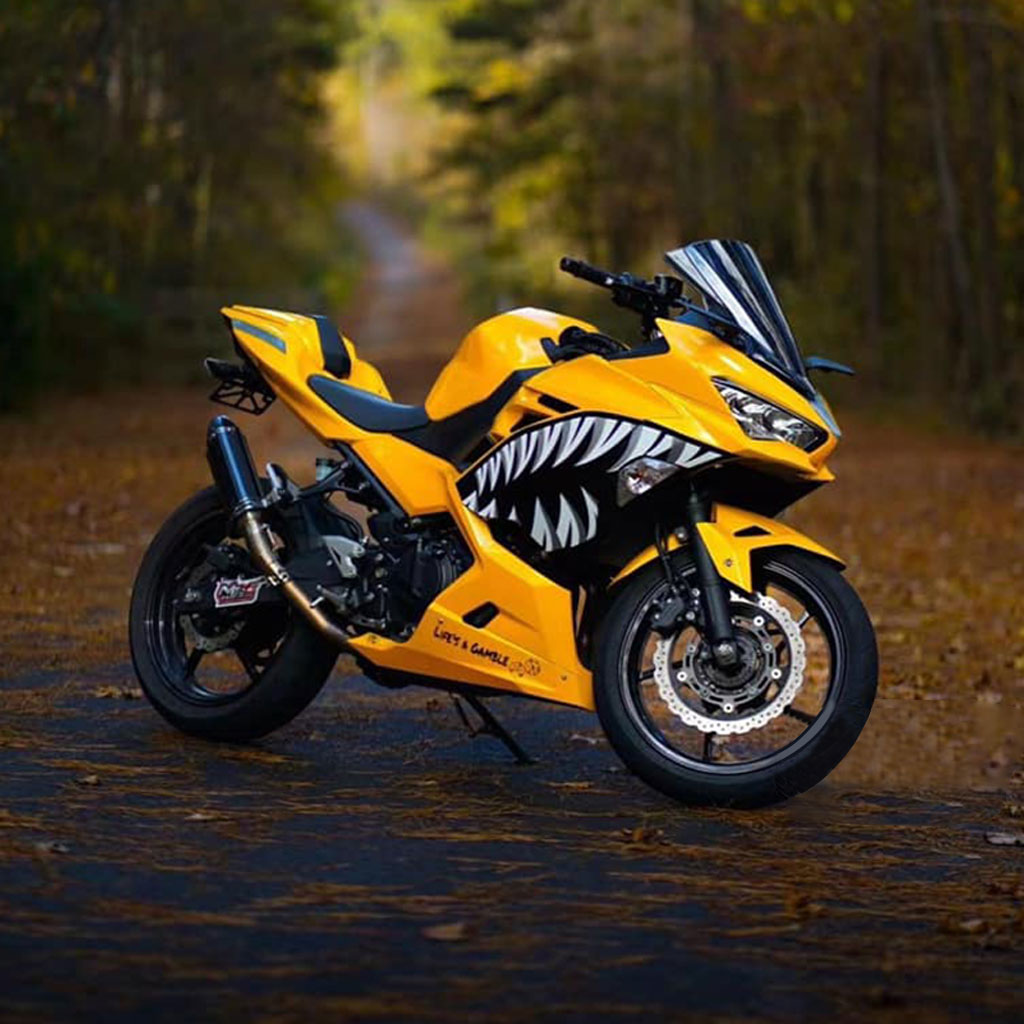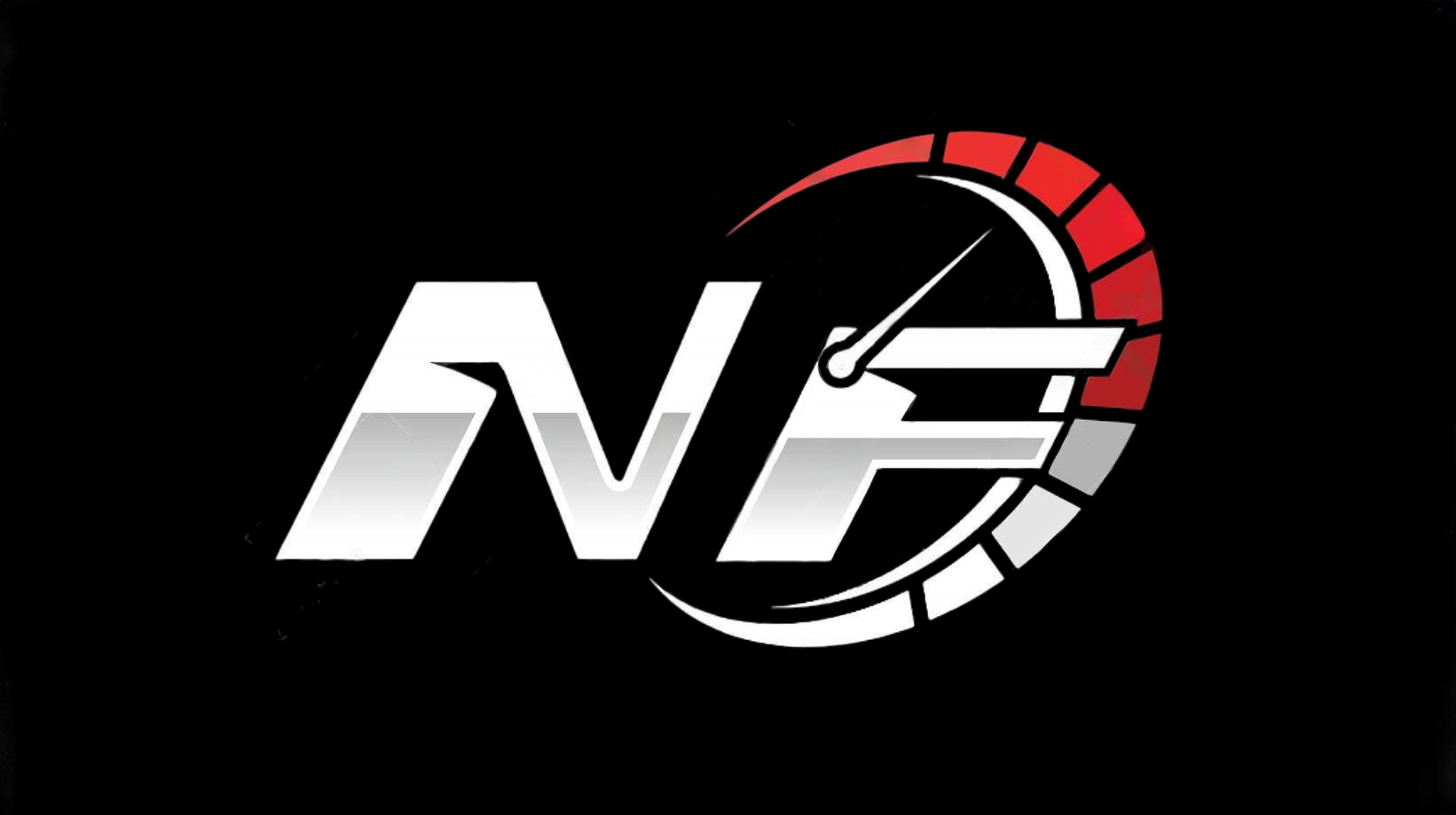Kawasaki Ninja 500R Acceleration and History Explained
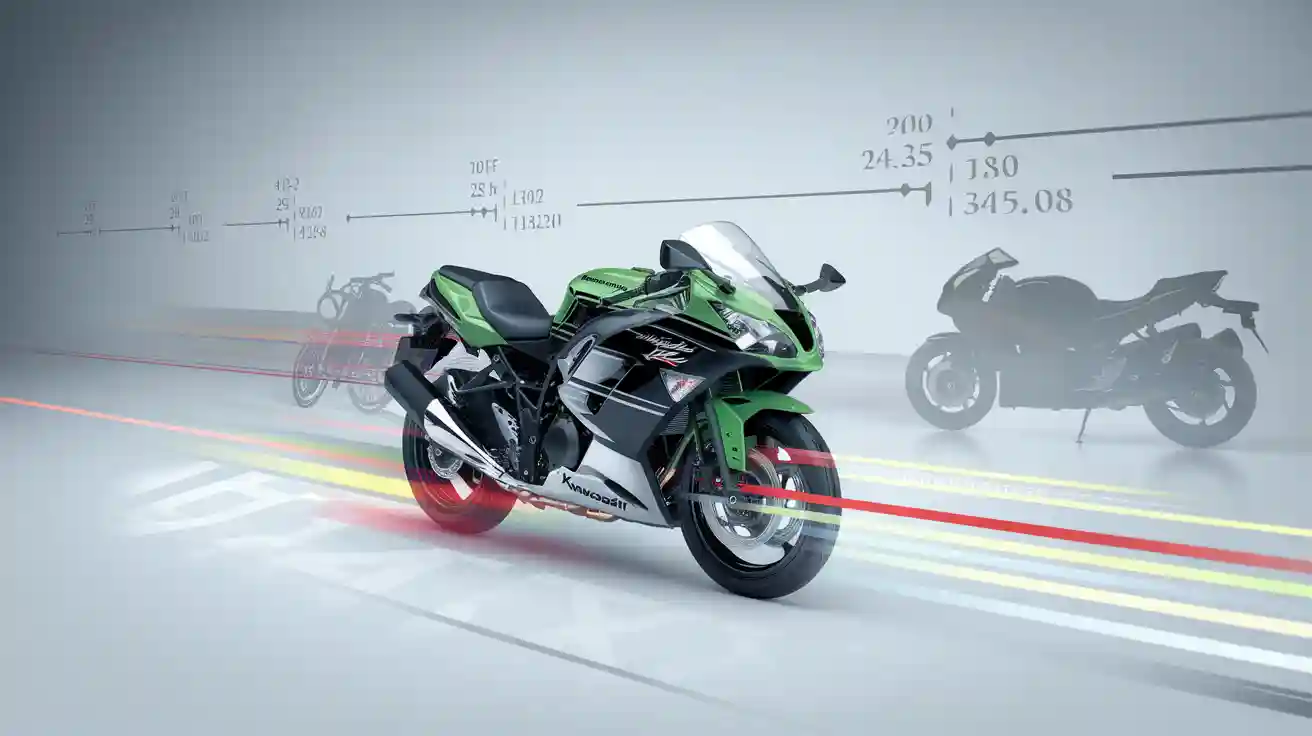
The kawasaki ninja 500r 0-60 acceleration time ranges from 4.0 to 4.6 seconds, with some riders recording even faster runs. Riders often compare the kawasaki ninja 500r to other bikes like the Suzuki DR650SE, but the ninja delivers better street speed and performance. The kawasaki twin-cylinder engine gives the 500r reliability and strong power for its class. Many riders value the ninja for its balance of speed and approachable handling.
Kawasaki Ninja 500R 0-60 Performance Specs
Engine and Power Output
The Kawasaki Ninja 500R uses a 498 cc liquid-cooled, four-stroke, parallel-twin engine. This engine features double overhead camshafts and four valves per cylinder. Riders notice the strong response from the engine, especially at higher rpm. The engine produces about 60 horsepower at 9,800 rpm and 46 Nm (34 lb-ft) of torque at 8,500 rpm. These specifications help the Ninja 500R deliver quick acceleration and smooth power delivery. The engine uses two Keihin CVK34 carburetors, which provide reliable fuel flow and easy starting.
| Specification | Details |
|---|---|
| Engine Type | Liquid cooled, four stroke, parallel twin, 4 valves per cylinder |
| Displacement | 498 cc |
| Bore x Stroke | 74 mm x 58 mm |
| Compression Ratio | 10.8:1 |
| Horsepower | 60 hp @ 9,800 rpm |
| Torque | 46 Nm (34 lb-ft) @ 8,500 rpm |
| Fuel System | 2x Keihin CVK34 carburetors |
The engine’s design allows the Kawasaki Ninja 500R to reach a 0-60 mph time as low as 3.76 seconds under ideal conditions. This makes the bike a strong performer in its class.
Weight and Power-to-Weight Ratio
The Kawasaki Ninja 500R weighs about 381 pounds (173 kg) with all fluids. Its lightweight steel trellis frame helps keep the bike agile and easy to handle. The combination of a light frame and a powerful engine gives the Ninja 500R a favorable power-to-weight ratio. This ratio is important because it affects how quickly the bike can accelerate and how it feels during sporty riding.
| Specification | Details |
|---|---|
| Curb Weight | Approximately 381 pounds (173 kg) |
| Dry Weight (non-ABS) | About 339.6 pounds |
| Engine Displacement | 498 cc parallel-twin |
| Horsepower | 60 hp @ 9,800 rpm |
| Torque | 46 Nm (34 lb-ft) @ 8,500 rpm |
| Frame | Lightweight steel trellis frame |
| Power-to-Weight Ratio | Favorable and competitive within 500cc sport bikes |
| Handling Characteristics | Agile, nimble, well-balanced for sporty and everyday riding |
- The Ninja 500R’s power-to-weight ratio is similar to that of some high-performance cars, such as the Dodge Challenger Hellcat.
- This ratio allows the bike to accelerate quickly and handle well in traffic.
- Motorcycles like the Ninja 500R have only two tires touching the road, so they cannot corner as fast as cars, but their small size makes them very maneuverable.
Tip: Riders often choose the Ninja 500R for its easy handling and strong acceleration, making it a good choice for both new and experienced riders.
Transmission and Gear Ratios
The Kawasaki Ninja 500R uses a six-speed, constant mesh transmission with a wet, multi-disc clutch. The gear ratios are designed to give strong acceleration in lower gears and efficient cruising in higher gears. The first gear has a high ratio, which multiplies engine torque for quick starts. Higher gears have lower ratios, which help the bike reach higher speeds without overworking the engine.
| Specification | Value |
|---|---|
| Primary drive ratio | 2.652 (23/61) |
| Final drive ratio | 2.625 (42/16 sprockets pre-1994), 2.5625 (41/16 sprockets 1994-2006) |
| Gear ratios (transmission) | 1st: 2.571, 2nd: 1.78, 3rd: 1.38, 4th: 1.12, 5th: 0.96, 6th: 0.85 |
| Overall gear ratios | 1st: 17.87, 2nd: 12.37, 3rd: 9.60, 4th: 7.83, 5th: 6.88, 6th: 5.92 |
| Max speed per gear @ redline | 1st: 44 mph, 2nd: 63 mph, 3rd: 82 mph, 4th: 101 mph, 5th: 118 mph, 6th: 133 mph |
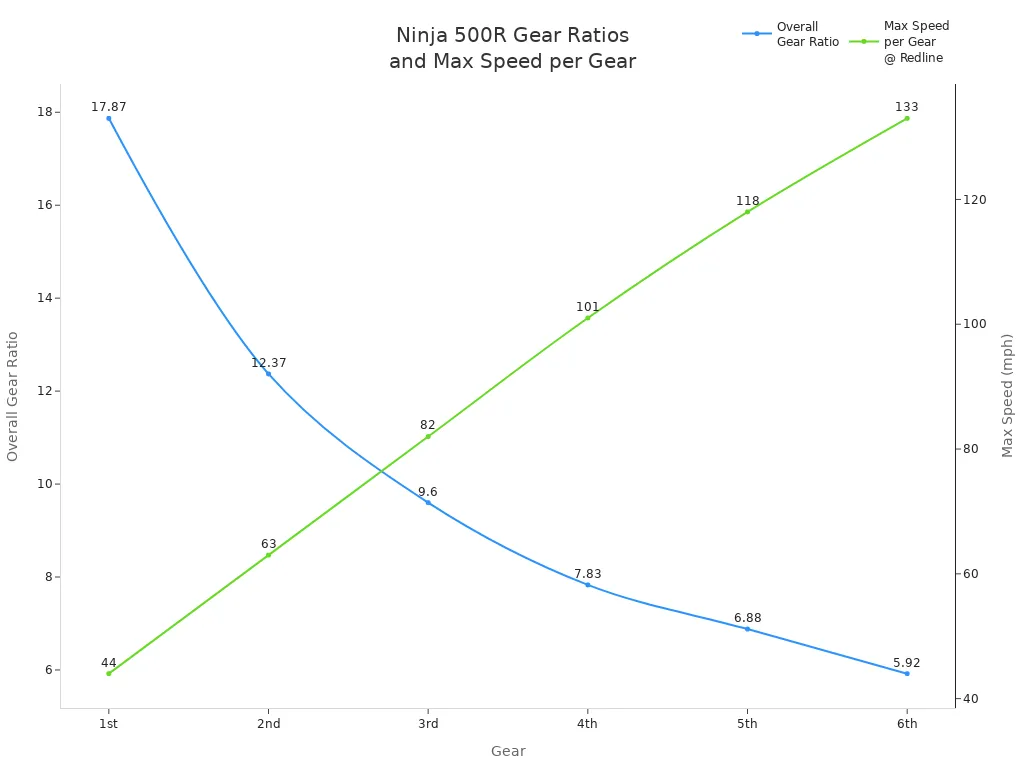
Performance tests show that the Ninja 500R can reach 60 mph in under 4 seconds. The gear ratios help the engine stay in its best power range, so the bike accelerates quickly and smoothly. The transmission also allows for easy shifting, which helps riders keep control during fast starts and high-speed riding.
Kawasaki Ninja 500R Evolution and History
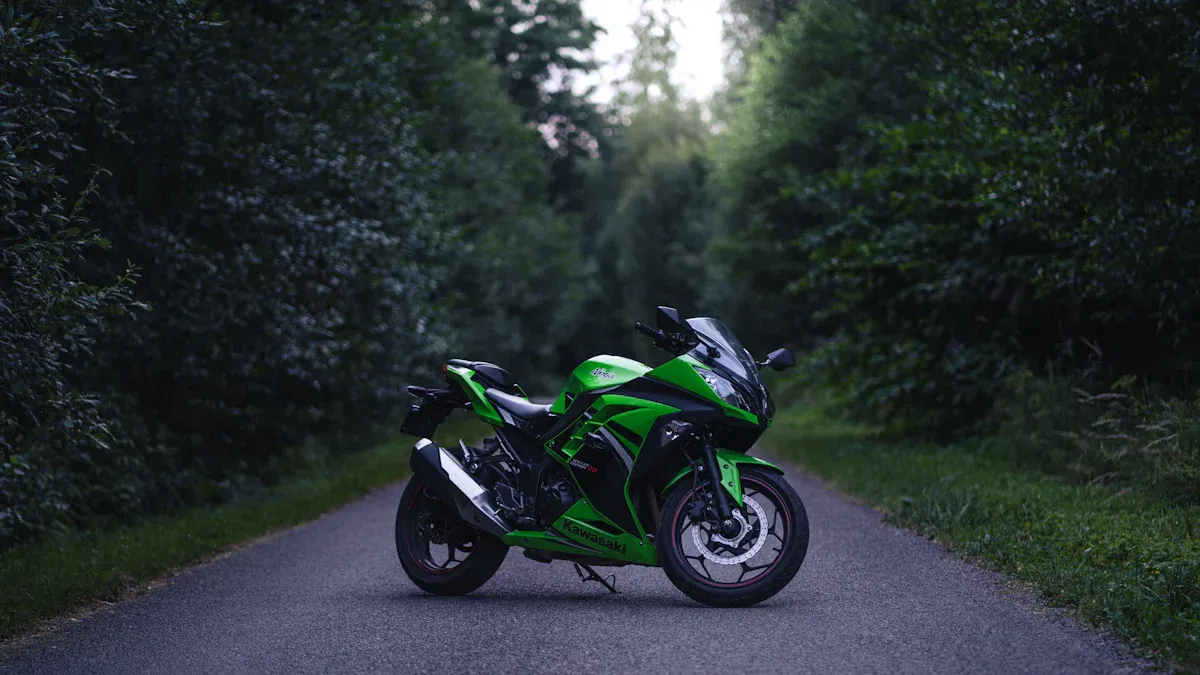
Origins and Early Development
Kawasaki introduced the Ninja 500R in 1987, originally calling it the EX500 and GPZ500S in some markets. The company wanted to create a motorcycle that combined sporty looks with everyday comfort. Kawasaki designed the bike with a more upright riding position, making it easier for riders to handle on city streets and longer trips. The Ninja 500R became popular because it offered good performance and low maintenance costs. Riders from different backgrounds found it appealing, especially beginners and those looking for a reliable, affordable motorcycle. The Ninja series has always stood for engineering excellence and design innovation, and the 500R continued this tradition by blending style, comfort, and performance.
Key Model Updates and Milestones
Kawasaki made several important updates to the Ninja 500R over the years:
- The engine displacement increased from 399cc to 451cc by lengthening the stroke, which improved power and made the bike faster at lower speeds.
- Kawasaki added a slipper clutch to help with smoother downshifts and better control.
- The chassis, suspension, and braking systems stayed similar to earlier models, keeping the bike balanced and easy to ride.
- Styling updates gave the bike a more aggressive look, matching the appearance of Kawasaki’s larger superbikes.
- The Ninja 500R kept its simple design and reasonable price, making it a favorite for new riders and those on a budget.
These changes helped the Ninja 500R stay popular for many years, especially among entry-level sportbike fans.
Impact of Changes on Performance
Kawasaki’s updates to the Ninja 500R led to real improvements in how the bike performed. The larger engine, with new parts like a longer stroke and optimized compression ratio, gave the bike more power and quicker acceleration. A downdraft intake and a bigger airbox helped the engine breathe better, especially at high speeds. The lightweight trellis frame, inspired by other Kawasaki models, made the bike nimble and easy to handle. The assist and slipper clutch reduced the effort needed to shift gears and improved safety during hard braking. Riders noticed that the bike felt smoother and more responsive, with better control in corners and during quick stops. These changes made the Ninja 500R a strong choice for riders who wanted both speed and reliability.
2007 Kawasaki Ninja 500R: A Benchmark Year
Performance Highlights
The 2007 kawasaki ninja 500r stands out as a top choice for riders who want a balance of power and control. Kawasaki designed this model with a 498cc parallel twin engine that produces 49 horsepower and 31 ft lbs of torque. The engine uses twin Keihin CVK 34mm carburetors, which help deliver smooth and reliable power. Riders appreciate the six-speed manual transmission, which allows for quick acceleration and easy shifting. The bike reaches 0-60 mph in just 4.5 seconds, making it one of the fastest in its class for the time. The dry weight of 388 pounds gives the ninja a strong power-to-weight ratio, which helps with both speed and handling. Many riders find the comfortable riding position and light weight make the 2007 kawasaki ninja 500r easy to control, even for beginners. The model kept its carbureted fuel system and core engine design from earlier years, but its performance remained competitive and well-regarded.
| Performance Metric | 2007 Kawasaki Ninja 500R Details |
|---|---|
| Engine Type | 498cc parallel twin, liquid-cooled |
| Horsepower | 49 hp |
| Torque | 31 ft lbs |
| Carburetion | Twin Keihin CVK 34mm carburetors |
| Transmission | 6-speed manual |
| Dry Weight | 388 lbs |
| 0-60 mph Acceleration Time | 4.5 seconds |
| Power-to-Weight Ratio | 1.28 (cc to weight) |
Notable Features and Improvements
Kawasaki included several features in the 2007 ninja that improved the riding experience for both new and experienced riders:
- The liquid-cooled, inline twin-cylinder engine with dual overhead cams and four valves per cylinder delivers user-friendly yet spirited power.
- The UNI-TRAK® rear suspension system, similar to larger kawasaki models, provides a smoother and more controlled ride.
- Aerodynamic half-fairing and lower fairing offer better wind protection and modern styling.
- The double-cradle steel box-section frame increases rigidity and keeps the bike lightweight for precise handling.
- Suspension includes 37mm front forks and a bottom-link UNI-TRAK® rear suspension, which lowers the center of gravity.
- Front and rear disc brakes with dual-piston and single-piston calipers ensure strong and controllable stopping power.
- 17-inch wheels allow for modern, low-profile tires, improving grip and stability.
- Additional features such as a six-speed transmission, digital ignition, and positive neutral finder make the bike easier to use every day.
Note: These improvements give the ninja stable handling, smooth power delivery, and comfortable ergonomics. Riders enjoy both daily commuting and spirited rides thanks to these thoughtful upgrades.
Kawasaki Ninja 500R vs. Similar Bikes
Comparison with Other 500cc Sport Bikes
Many riders compare the Kawasaki Ninja 500R to other 500cc sport bikes, especially the Suzuki GS500F. Both bikes target riders who want a mix of performance and comfort. The Kawasaki stands out with its liquid-cooled, eight-valve parallel-twin engine. This engine gives strong low to midrange power and a pleasing vibration. The Suzuki uses an air-cooled, four-valve engine that needs high revs to reach its best power. Riders notice the Suzuki feels smoother at lower speeds but creates a high-pitched buzz at high rpm.
The Kawasaki weighs less than the Suzuki. This lighter weight helps with handling and makes the bike feel more agile. The Suzuki gained weight over the years but did not get more power. Handling on the Kawasaki feels sharper, though some riders mention the steering feels a bit unnatural at low speeds. The Suzuki offers more comfort and a larger fuel tank for longer rides. Price also matters. The Kawasaki costs less, making it a better value for many riders.
| Aspect | Kawasaki Ninja 500R | Suzuki GS500F |
|---|---|---|
| Engine | Eight-valve, liquid-cooled parallel-Twin; strong low to midrange power; coarse but pleasing vibration | Air-cooled, four-valve; requires high revving (8000-10,500 rpm) for power; smoother until high revs but produces high-pitched buzz |
| Weight | Lighter, no significant weight gain reported | Heavier, weight gain without power increase |
| Handling | Better handling and performance; some unnatural low-speed steering | Less sharp handling; more comfortable ergonomics |
| Fuel Tank | Smaller fuel tank | Larger 5.3-gallon tank for extended range |
| Price | Less expensive ($4799) | More expensive ($4999) |
Real-World Test Results
Riders and testers often share their experiences with the Kawasaki Ninja 500R in real-world conditions. Many say the Kawasaki delivers stronger midrange power and torque, especially between 3500 and 7000 rpm. This extra power helps the bike accelerate faster out of corners and improves street performance. Dyno tests show the Kawasaki produces about 57 horsepower, which is higher than the 49-50 horsepower seen on some modified 400cc models.
Handling, suspension, and brakes feel similar to smaller bikes, but the Kawasaki's extra power and torque make it more comfortable and capable for both street and track riding. Riders often say the Kawasaki feels like a bigger bike with more usable power. They can carry more speed through corners and often ride in a higher gear than on smaller bikes. The redesigned seat on the Kawasaki also adds comfort, making longer rides easier.
Note: These real-world results show that the Kawasaki Ninja 500R outperforms many similar bikes in midrange power, torque, and acceleration. Riders enjoy both the performance and comfort it offers.
Real-World Rider Experiences with Kawasaki Ninja 500R
User Reviews on Acceleration
Many riders share positive feedback about the Kawasaki Ninja 500R’s acceleration and engine feel. Common themes in user reviews include:
- The engine runs smoothly and feels refined, even at low speeds.
- Strong low-end torque allows comfortable riding in higher gears without frequent shifting.
- Acceleration above 5000 rpm impresses many riders, giving a noticeable pull compared to smaller bikes.
- The gearbox offers short, precise shifts. Riders appreciate the positive neutral finder, which makes finding neutral easy at stops.
- The clutch feels light and forgiving. This helps in stop-and-go traffic and complements the torquey engine.
- The relaxed riding posture reduces strain on wrists and back, making the bike suitable for both city and highway use.
- Riders consider the Kawasaki Ninja 500R a reliable and capable machine in the 500cc class. It can cruise at speeds over 140 km/h without stress.
- Some mention minor drawbacks, such as non-adjustable levers and limited electronics, but these do not affect the overall ride quality.
Note: Many riders say the Kawasaki Ninja 500R 0-60 acceleration stands out in its class, offering both excitement and control.
Everyday Performance Impressions
Riders find the Kawasaki Ninja 500R well-suited for daily commuting and longer trips. The balanced parallel-twin engine delivers smooth acceleration and manageable power, especially in city traffic. The bike’s upright seating, wide handlebars, and well-placed foot pegs provide comfort for extended rides. Vibration damping in the seat and handlebars helps reduce fatigue on longer journeys. Safety features, such as selectable ABS, give riders more confidence in different road conditions.
Compared to other sport bikes, the Kawasaki Ninja 500R offers a strong mix of performance and comfort. The bike’s torque makes it easy for new riders to handle, while modern features like LED lighting and an LCD dash improve usability. Riders who want a comfortable yet sporty motorcycle often choose this model. The combination of comfort, accessibility, and performance makes the Kawasaki Ninja 500R a standout in the under-500cc sport bike category.
The kawasaki ninja 500r 0-60 acceleration remains impressive, offering a strong mix of speed and everyday usability. Riders continue to choose this kawasaki for several reasons:
- Balanced performance for both commuting and weekend rides
- Comfortable ergonomics and agile handling
- Reliable design with minimal maintenance
- Attractive styling and competitive pricing
The latest kawasaki models build on this legacy, adding modern features and improved comfort. This sportbike stands out as a top choice for those who value performance, history, and versatility.
FAQ
What is the top speed of the Kawasaki Ninja 500R?
The Kawasaki Ninja 500R can reach a top speed of about 120 mph. Riders often report stable performance at highway speeds. This makes the bike suitable for both city and highway riding.
How much maintenance does the Ninja 500R require?
The Ninja 500R needs regular oil changes, chain adjustments, and brake checks. Many owners find the bike easy to maintain. Parts are widely available, and most repairs do not require special tools.
Tip: Regular maintenance helps the Ninja 500R last longer and perform better.
Is the Kawasaki Ninja 500R good for beginners?
Yes, many riders recommend the Ninja 500R for beginners. The bike offers manageable power, light weight, and easy handling. New riders often feel confident because of the comfortable seating and predictable throttle response.
What fuel economy can riders expect from the Ninja 500R?
| Riding Style | Average MPG |
|---|---|
| City | 45-50 |
| Highway | 50-60 |
Riders usually get between 45 and 60 miles per gallon. The actual mileage depends on riding habits and road conditions.
See Also
Detailed Analysis Of Kawasaki Ninja 650 Fairing Performance
Complete 2025 Review Of The Kawasaki Ninja H2R Model
Reasons Behind Choosing To Purchase A Kawasaki Motorcycle
